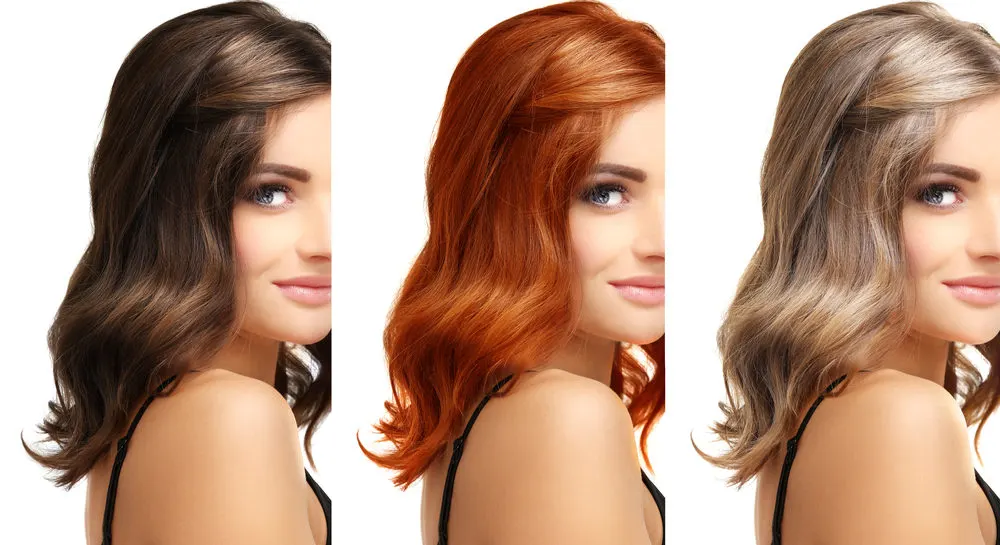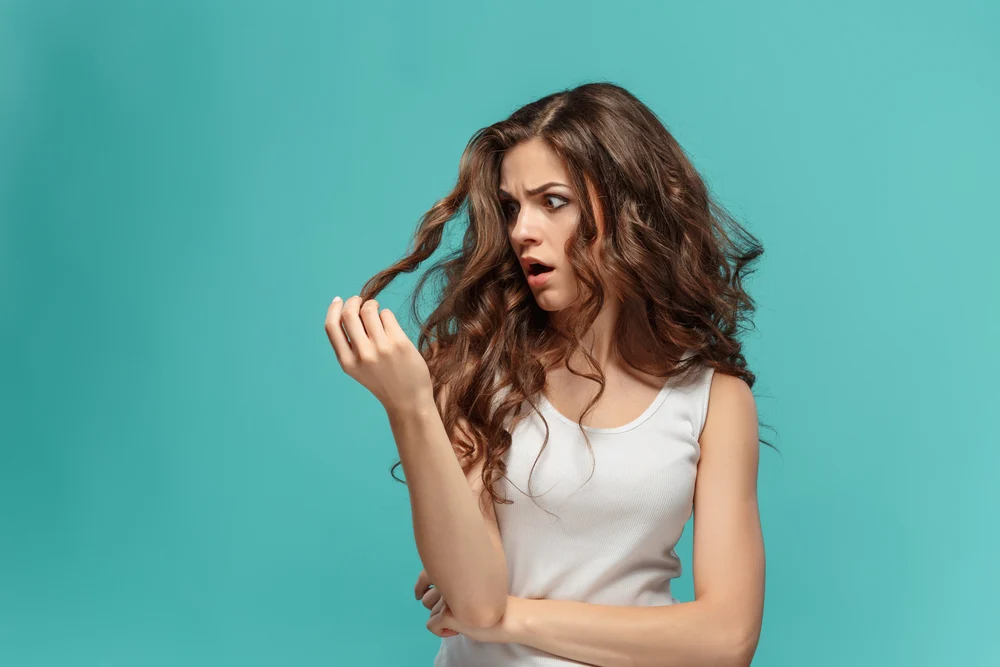Jump to:
If you find yourself wondering, “why is my hair color changing by itself,” then you’ve come to the right place. While it may seem far-fetched, there are a few reasons your hair may be changing color naturally. No, you’re not going crazy.
It is a few shades lighter than it was at the start of summer. Here we will explore the seven common reasons why your hair may be changing color, as well as take a look at some frequently asked questions on the topic.
7 Reasons Your Hair Color Can Change by Itself

Lado/Shutterstock
While there are too many factors to count that can change the state of your hair, here are the seven common ones responsible for changes to hair color.
1. Sunlight
Ultraviolet light breaks down melanin through repeated and extended exposure. This will result in the top layers of hair that are most frequently exposed to sunlight bleaching over time.
With enough direct sunlight, you may start to notice a significant difference between the color of the top layers of your hair and the underside. While this can give you some natural variation in color and even create a soft ombre through the years, too much sun exposure can also damage your hair.
The same UV light that lightens your hair also breaks down other chemicals in your hair and weakens the outside shell of individual hair strands. Too much exposure to sunlight can make hair dry, brittle, split, thin, and frizzy.
2. Age
Melanocytes, the cells in your hair follicles that produce melanin, decrease with age. For young people, the type of melanin dictates hair color. Eumelanin is responsible for the blonde, brown, and black spectrum.
The more eumelanin you have, the darker your hair. Pheomelanin is responsible for red hair. A lack of eumelanin and high levels of pheomelanin leads to bright red hair. Having both eumelanin and pheomelanin in stronger proportions can lead to colors such as strawberry blonde and auburn.
As melanocytes decrease with age, so too does the amount of melanin in each strand of hair. Eventually, there is no melanin left, and your hair grows gray.
3. Hard or Rusty Water
Hard and rusty water can affect your hair color thanks to its mineral content. Minerals like calcium, copper, iron oxide, and magnesium can coat and stain hair strands enough to change the color.
People with light and blonde hair will more easily notice a difference as extremely light hair can turn orange with enough frequent exposure.
While this process isn’t harmful to the hair, it can leave it feeling dry and make it look faded or dull. It can also complicate the process of maintaining dyed hair.
Read Next: How to Boil Hard Water to Wash Your Hair
4. Chlorine
Similarly to hard and rusty water, chemicals like chlorine can change your hair color. If you have a backyard pool or swim at the community center a lot, the chlorine in the pool water can be damaging your hair.
As you may recall, chlorine is a bleaching agent used in cleaning products such as chlorine bleach to kill germs and break down dirt. While chlorine is a super effective cleaner, it’s not kind to hair.
Over time it can lighten hair, but it also damages the outer layer just like sunlight. Damaging the shell of a strand of hair can prevent it from being able to retain new color through dying, make it harder to bleach, and lead to breakage and frail hair.
5. Stress and Medical Conditions
Stress and certain medical conditions can have a huge impact on your hair’s appearance. Stressful events can result in hair loss up to three months after the inciting incident.
Your body will experience a period of high stress that changes the hormones in your body. This fight or flight response takes a while to assuage, and the effects may not make themselves known until some time later.
Prolonged periods of stress can have significant and life-long health effects, but they can also change your hair permanently. During periods of extended stress, your body shuts down less necessary functions. This can lead to things like digestive problems and a weakened immune system.
But it can also permanently reduce the number of melanocytes in your hair follicles. The result is early graying. It’s common for people in high-stress jobs.
Illness and certain medical conditions can also change the quality of your hair. Not being able to absorb specific nutrients, for instance, can lead to dull, brittle hair and nails. Some treatments, like chemotherapy, can also result in hair loss.
6. Heat Damage or Hair Products
With temperatures reaching around 450 degrees Fahrenheit, it’s no wonder heat styling can permanently damage your hair. Frequent heat styling damages the hair shaft and can leave hair looking faded and dull.
Chemically treated hair is at notably higher risk from heat styling as the strands are already weakened and more susceptible to further damage.
Chemical treatments and certain products will also damage hair enough that it can lose color over time. Curlers, flat iron, hot combs, and blow dryers can all lead to damaged hair.
Using extreme heat on wet hair will boil your hair and form bubbles in the strands that cause easy breakage. Turn down the heat and use heat styling less to save your hair.
Read Next: How to Straighten Your Hair Without Heat
7. Pregnancy
The elevation of certain hormones during pregnancy, such as estrogen, can lead to changes in hair growth cycles. Many women experience longer hair growth cycles that produce thicker, shinier, and sometimes differently textured hair.
Progesterone and cortisol also play a role in hair changes during pregnancy. They can make the hair appear lighter or darker depending on the person. These changes affect hair all over your body.
While some of these changes may be favorable, they are almost always temporary, and the hair cycle will return to normal after pregnancy. This often takes the form of sudden and extensive hair loss and thinning. Over time the hair will return to its usual regime and appearance.
Frequently Asked Questions

Master1305/Shutterstock
Still have questions about your hair changing colors? We’ve got answers to some of the most common.
Is there a disease that makes your hair change color?
Yes, some diseases can result in hair color changes. Waardenburg syndrome can cause hearing loss and pigment changes in hair, skin, and eyes.
What is the most common hair color?
Black hair is the most common, with a staggering 85% of the world’s population possessing black hair. Around 11% have brown hair, 2% have blonde hair, and 1% have red.
What is it called when your hair naturally changes color?
Achromotrichia is a term that means an absence of pigment in the hair. It most often happens naturally through aging.
Can your diet change your hair color?
Yes, certain dietary patterns can change your hair color, but usually not for the better. Biotin is a vital component in healthy hair growth that comes from proper gut bacteria that produces B vitamins. A lack of biotin can change your hair color, cause it to thin, and make it weak.
What is the rarest color of hair?
Red is the rarest hair color. As mentioned earlier, you need a specific set of genetics to allow for red hair, and the genotypes must present in distinctive ways to result in red hair phenotypes. You need to have the genetic predisposition for pheomelanin, have it present strongly, and have little to no eumelanin to end up with red hair.
So, Why Does Your Hair Change Color by Itself?
While there are many reasons for your hair to change color naturally, the most common causes are sunlight, age, and damage from products and styling.
While not all causes for hair color changes are necessarily bad, many of them can seriously damage your hair and ruin your dreams of healthy locks.
